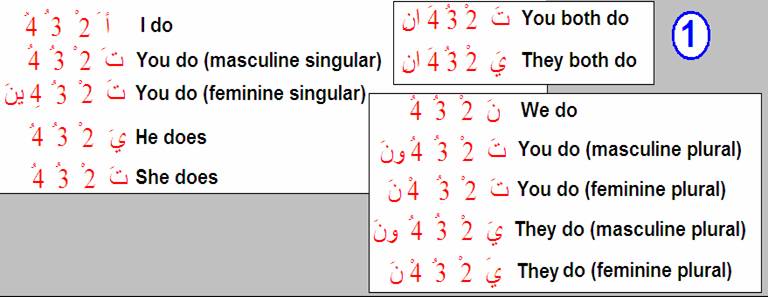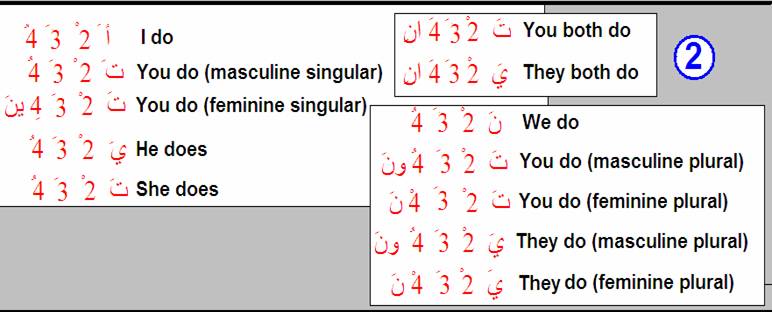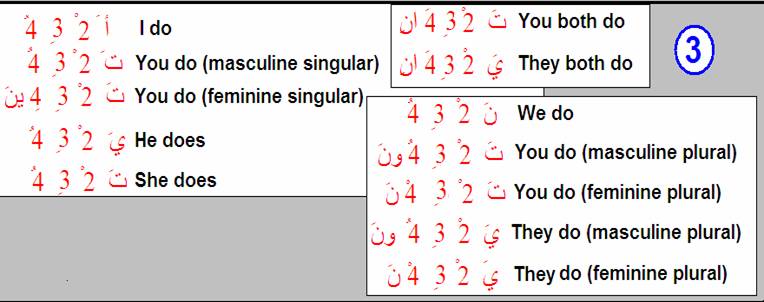|
|
WorldOfIslam.info - Intro
|
|
Learn Arabic Online /
اللغة العربية
Arabic Present Tense
The easiest way to learn how to conjugate Arabic verbs to the present tense
is to look at the table below:

It�s very easy to put hundreds of verbs in the model
above, just replace the numbers with the three
consonants of the verb:
# 2 = first consonant, # 3 = second consonant, # 4 =
third consonant. You will notice that there are some letters before the
numbers 2, 3, 4, you shouldn�t replace the letters, the only thing you
should replace are the numbers, vowels (symbols) + the letters should stay.
For example the verb (to draw) is
(rasama
رسم
)
in Arabic, to conjugate it into the first person singular (I draw), try to
use the form next to ( I do) on the top, which is
 ,
in other words, always use the Alef أ
as a first letter for the first person singular, then replace the
letter # 2 with the first consonant of the verb you�re conjugating (in our
case it�s the verb
رسم)
meaning that the number 2 should be replaced with �ر�
, number 3 should be replaced with the second consonant which is
س
, # 4 should be replaced with the third consonant which is the letter
م
.
if you followed the steps the right way, then you will end up having
أرسُمُ
which means �I draw�, this rule applies to the trilateral verbs (with some
exceptions), you can do the same thing with the rest, the table below shows
how I replaced the numbers 2, 3, 4 with the consonants
ر , س , م)
+ the letters that are unchanged like the Alef
أ
for the first person singular, the unchanged ( t
ت
) for the second person singular and so on�and the most important is the
vowels or symbols on the top of each consonant. ,
in other words, always use the Alef أ
as a first letter for the first person singular, then replace the
letter # 2 with the first consonant of the verb you�re conjugating (in our
case it�s the verb
رسم)
meaning that the number 2 should be replaced with �ر�
, number 3 should be replaced with the second consonant which is
س
, # 4 should be replaced with the third consonant which is the letter
م
.
if you followed the steps the right way, then you will end up having
أرسُمُ
which means �I draw�, this rule applies to the trilateral verbs (with some
exceptions), you can do the same thing with the rest, the table below shows
how I replaced the numbers 2, 3, 4 with the consonants
ر , س , م)
+ the letters that are unchanged like the Alef
أ
for the first person singular, the unchanged ( t
ت
) for the second person singular and so on�and the most important is the
vowels or symbols on the top of each consonant.
Please pay extra attention to the harakaat written in
Arabic, the three small symbols ( َ
ُِ ِِِِِِِِ
)
are very important in the tables below and above, because they play the role
of vowels, (
ََََََََ
= vowel a) (
ُُُُُُ
= vowel u) (
ِِِِِِِِ
= vowel i or
e),
|
Singular |
Dual |
|
I draw
= arsumu
أرسُمُ
you
draw (singular masculine) = tarsumu
ترسُمُ
you
draw (singular feminine) = tarsumeena
ترسُمِينَ
he
draws = yarsumu
يَرسُمُ
she
draws = tarsumu
تَرسُمُ |
you
draw (dual male or female) = tarsumani
تَرسُمَانِ
they
draw (dual male or female) = yarsumani
يَرسُمَانِ
Plural
we
draw = narsumu
نَرسُمُ
you
draw (plural masculine) = tarsumuna
تَرسُمُونَ
your
draw (plural feminine) = tarsumna
تَرسُمْنَ
they
draw (plural masculine) = yarsumuna
يَرسُمُونَ
they
draw (plural feminine) = yarsumna
يَرسُمْنَ
|
You can use the table above to conjugate hundreds of
verbs, like (to write كتب)
( to learn
درس)
(to dream
حلم)
( to protect
حرس)
�..
However some other trilateral verbs have some slightly
different forms, look at the table below, it looks almost similar to the one
on the top, with one exception, look at # 3, it has a vowel (symbol)
different than the table on the top, the one on the top has a (
ُ
)
on the top of number 3, while the table below has a symbol like ( َ
)
on the top of number 3, basically instead of using the vowel (u
ُ
)
we will use the vowel (a َ ) with some trilateral
verbs, like: to play
لعب,
to do
فعل
,
to go
ذهب
,
to swimسبح
�
but the rest of the consonants stay unchanged.

Finally there is a third table which will have also a
slight modification, on the same place as the one before, which is under
number 3,
instead of adding the vowel ( u ُ
)
or the vowel (a َ
), this time we will add the vowel ( e or i ِ
) to some verbs when conjugating them like:
to throw
قذف,
to hit
ضرب,
to beat
هزم
�..

www.worldofislam.info
|
|
|
|
 |
|
The
Holy Quran Quotes
- |
|
�Incline not unto those who do wrong, or the fires of Hell will touch you. You have no protector save Allah, and you will not be helped�
(Huud, 11:113)
|
 |
|
|